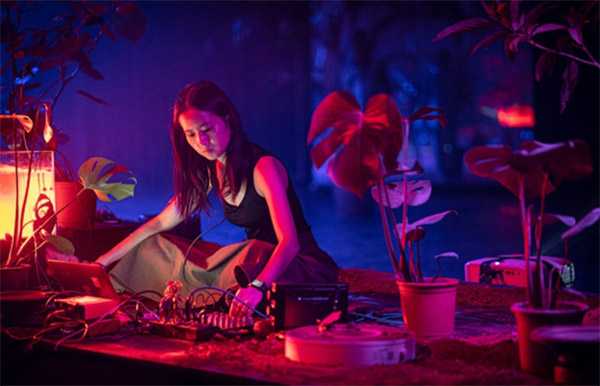본문
Jeju Biennale's Strategic Efforts to Engage More Closely with Jeju
[NEWS] Jeju Biennale's Strategic Efforts to Engage More Closely with Jeju
The 4th Event Scheduled: Runs from November 26 to February of Next Year
The Role of the Museum Expands, Emphasizing Jeju's Identity Through Space, Artists, and Side Events
Jeju Museum of Art (JMoA) will host the 4th Jeju Biennale from November 26 to February 16 of next year. Starting with the core theme of "drift," the event will expand its scope to cover topics such as the ocean, borders, migration, and refugees. Particularly mindful of the challenging conditions and the need for sustainability, the Biennale will focus on becoming more closely integrated with Jeju, a determination reflected throughout the entire exhibition.
At a press conference on the 29th, Director Lee Jong-hoo of Jeju Museum of Art announced the theme of the 4th Jeju Biennale, The Drift of Apagi: The Way of Water, Wind, and Stars, along with the participating artists and programs.
According to the Jeju Museum of Art, the theme of the 4th Jeju Biennale has been set as "drift." The exhibition will explore how drift interacts with our perceptions on the journey of civilization, reinterpreting the boundaries of encounters, clashes, and fusions at the crossroads of chance and inevitability from an artistic perspective. It will also delve into contemporary issues such as civilization, the environment, migration, and refugees, proposing the concept of a new alternative community.
Exhibition venues will include the Jeju Museum of Art, Public Storage for Arts of JMOCA, the Jeju Folklore & Natural History Museum, the International Convention Center Jeju (ICC Jeju), and the tentatively named Jeju Art Platform.
The title character, Apagi, is inspired by a historical figure—Prince Apagi of the Tamna Kingdom, who encountered Japanese envoys drifting to Tamna during the Tang Dynasty trade. The exhibition theme extends this historical anecdote into an imaginative fictional drift journey. By incorporating imaginative elements into the historical background, the main exhibition space at the Jeju Museum of Art is designed to make visitors feel as if they are embarking on an exploration.
The exhibition is structured to depict a journey beginning at the fictional island of Unhanmoe, encountering a storm, passing through Sabadang, an island where birds rest, and maturing through a voyage guided by water, wind, and stars, ultimately reaching an ideal destination. Apagi’s journey symbolizes the idea that life itself is a voyage and a drift.



lololol, Sun Moon Lake is a Concrete Box Revisited, 2024 / Photographed by JMoA
A total of 39 artists (teams) from 14 countries will participate in the exhibition, including Koh Gilcheoun, BOO Jihyun, Shin Hyung Sub , Kura Yang, Han Seung Ku, Pangrok Sulap, Huiying Ore, Wan Othman, Wuttin Chansataboot, lololol, and Tooraj Khamenehzadeh.
Of these, 17 are domestic artists, and 22 are international artists. The participation rate of artists from Asia (9 countries, 34 teams) is higher than that of Europe and the Americas (5 countries, 5 teams). Among the 17 domestic artists, 9 are from Jeju.
The exhibition will feature works across various genres and media, including painting, installation, photography, video, and performance. It will also present a wide range of forms, from research-based archiving works to high-tech new media art (metaverse, AI, projection mapping) and community art. Many of the works will be new creations, including those produced while the artists stay in Jeju.
Notably, Dr. Wan-Soo Lim, Director of the Community Mapping Center and Associate Professor at Meharry Medical College in the U.S., will conduct a workshop in Jeju in August. This workshop will involve local environmental groups, artists, and interested residents in a community project linking the exhibition theme of "drift" with environmental issues, such as marine debris. The process and outcomes of this project will be exhibited as part of the Biennale.
Side events will include performances, academic programs, experiential programs such as exhibition-related workshops, and artist talks.
To ensure that the Biennale is not merely an insular event, a networking program called "Connect Jeju" will be organized, allowing domestic and international art professionals and visitors to explore Jeju artists' studios and residency programs during the event. There will also be collaborative works and lectures involving the participating artists and art students from Jeju National University.
Director Lee Jong-hoo stated, "Through the theme of “drift” in this exhibition, we aim to examine how Jeju's identity is intertwined with and shaped by the flow of civilization in an international context. We will strive to make the Biennale resonate with everyday life and form a broad consensus, rather than being limited by difficult art criticism language."
Source: Han Hyung-jin, Jeju Sori
http://www.jejusori.net/news/articleView.html?idxno=428880

























